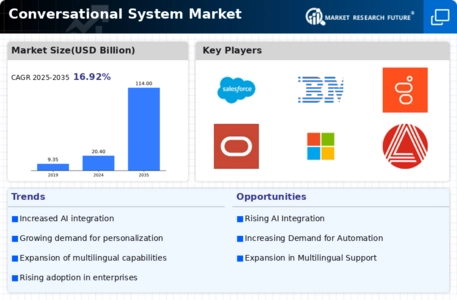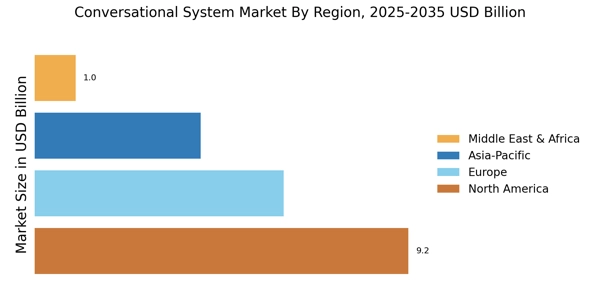Integration with IoT Devices
The integration of conversational systems with Internet of Things (IoT) devices is reshaping the Conversational System Market. As smart devices proliferate, the demand for seamless interaction between users and their devices grows. Conversational systems serve as a bridge, allowing users to control and communicate with IoT devices through natural language. This integration enhances user experience and convenience, as individuals can manage their smart homes or workplaces effortlessly. Market analysis suggests that the number of connected IoT devices is expected to reach 30 billion by 2025, further driving the need for effective conversational interfaces. This trend indicates a promising avenue for growth within the conversational systems sector.
Advancements in Natural Language Processing
Advancements in Natural Language Processing (NLP) significantly influence the Conversational System Market. Enhanced NLP capabilities enable conversational systems to understand and respond to human language with greater accuracy and context awareness. This evolution is crucial as users expect more intuitive and human-like interactions. Recent studies indicate that systems equipped with advanced NLP can improve user engagement rates by over 40%. As technology continues to evolve, the integration of sophisticated NLP algorithms allows businesses to create more personalized and effective conversational experiences. Consequently, organizations are increasingly investing in NLP-driven solutions to stay competitive in a rapidly changing market.
Increased Focus on Data Privacy and Security
In the Conversational System Market, there is an increasing focus on data privacy and security. As organizations deploy conversational systems, they must address the growing concerns surrounding user data protection. Regulatory frameworks, such as GDPR, compel businesses to implement robust security measures to safeguard user information. This emphasis on privacy not only builds trust with consumers but also enhances the overall credibility of conversational systems. Companies that prioritize data security are likely to gain a competitive edge, as users become more discerning about the platforms they engage with. Consequently, the market is witnessing a shift towards solutions that incorporate advanced security protocols, ensuring compliance and user confidence.
Rising Demand for Customer Support Automation
The Conversational System Market experiences a notable surge in demand for customer support automation. Businesses increasingly recognize the efficiency and cost-effectiveness of deploying conversational systems to handle customer inquiries. According to recent data, companies utilizing chatbots and virtual assistants report a reduction in operational costs by up to 30%. This trend is driven by the need for 24/7 customer service availability, which enhances customer satisfaction and retention. As organizations strive to improve their service delivery, the integration of conversational systems becomes a strategic imperative. The ability to manage high volumes of customer interactions without compromising quality positions conversational systems as a vital component in the customer support landscape.
Growing Investment in Conversational AI Startups
The Conversational System Market is witnessing a surge in investment directed towards conversational AI startups. Venture capitalists and investors are increasingly recognizing the potential of innovative solutions that leverage AI to enhance user interactions. This influx of capital is fostering a vibrant ecosystem of startups focused on developing cutting-edge conversational technologies. Recent reports indicate that investment in conversational AI startups has increased by over 50% in the past year, reflecting the growing confidence in the market's future. As these startups introduce novel applications and functionalities, they contribute to the overall evolution of the conversational systems landscape, driving competition and innovation.


















Leave a Comment